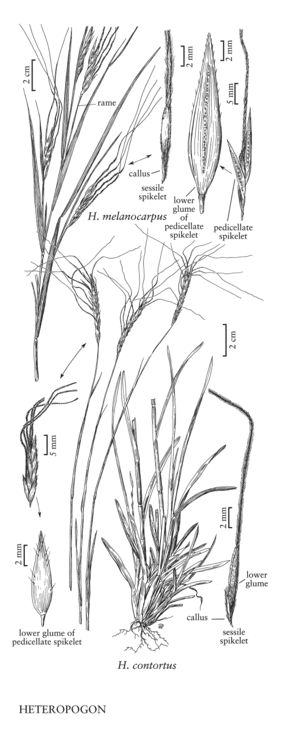Heteropogon contortus
Plants perennial. Culms 20-150 cm, erect. Sheaths smooth, reddish; ligules 0.5-0.8 mm, cilia 0.2-0.5 mm; blades 10-15 cm long, 2-7 mm wide, flat or folded, glabrous or pubescent. Rames 3-7 cm, secund, with 12-22, brown to reddish-brown, sessile-pedicellate spikelet pairs. Homogamous spikelets 6-10 mm. Heterogamous spikelets: sessile spikelets 5-10 mm, brown, awned; calluses 1.8-2 mm, strigose; awns 6-10 cm; pedicellate spikelets 6-10 mm, unawned; glumes ovate-lanceolate, glabrous or with papillose-based hairs distally, without glandular pits, greenish to purplish-brown, becoming stramineous when dry. 2n = 40, 50, 60.
Distribution
N.Mex., Tex., Calif., Puerto Rico, Virgin Islands, Pacific Islands (Hawaii), Ariz., Fla.
Discussion
Heteropogon contortus grows on rocky hills and canyons in the southern United States into Mexico, and worldwide in subtropical and tropical areas, occupying a variety of different habitats, including disturbed habitats. It is probably native to the eastern hemisphere but is now found in tropical and subtropical areas throughout the world.
Heteropogon contortus is a valuable forage grass if continuously grazed so as to prevent the calluses from developing. It is also considered a weed, being able to establish itself in newly disturbed and poor soils.
Selected References
None.
